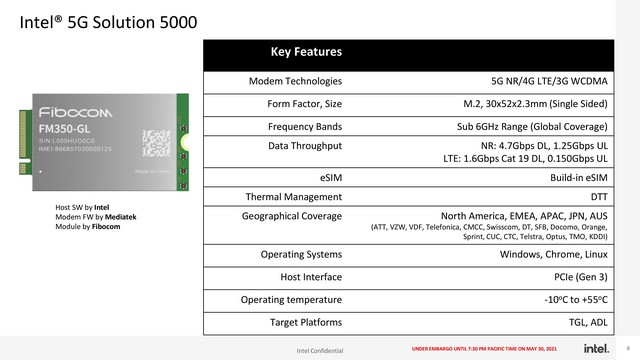Now, before talking about the latter, let me give you a quick rundown of the two new Intel Core U-series processors.
Intel Tiger Lake U-Series Processors Launched
Starting with the new Intel Core i7-1195G7 processor, it is the first TGL-U processor that can reach up to 5.0 GHz via the company’s “favored core” technology dubbed the turbo Boost Max 3.0. The 4-core/8-threads processor also has a 2.9 GHz base frequency, a 4.6 GHz all-core frequency, and Intel Iris XE integrated graphics (clocked at 1400MHz). Plus, the processor will support up to 64GB of DDR4-3200 RAM or up to 32GB of LPDDR4X-4266 RAM. Coming to the second processor, the Intel Core i5-1155G7 is refreshed version of the existing Core i5-1145G7. It is also has a 4-core and 8-threads design and boasts a max single-core frequency of 4.5 GHz. The new Core i5 processor features a base frequency of 2.5 GHz. It also packs Intel Iris XE graphics with 80 execution units and a peak frequency of 1350 MHz.
Intel 5G Solution 5000
Now, turning to the first-ever 5G-ready module from the chipmaker, the Intel 5G Solution 5000 is developed in partnership with MediaTek and Fibocom. The company sold off its 5G unit to Apple back in 2019. Following this, Intel announced its partnership with MediaTek to jointly develop 5G modems for laptops and the Intel 5G Solution 5000 is the result of that venture.
Turning to the product itself, it is an M.2 module that supports 5G Sub-6 GHz, 4G LTE, and 3G WCFMA. It communicates over the PCIe 3.0 interface and supports Windows, Linux, Chrome. Moreover, it can deliver 4700 Mbps download and 1250 Mbps upload speeds over 5G. So, these were the products unveiled by Intel at its Computex 2021 virtual conference. In addition to these two new Tiger Lake U-series processors, the company aims to add many more variants to the said line in the coming days. It also expects 60+ laptops to feature its 11-Gen Tiger Lake U-series CPUs, moving forward. As for the Intel 5G Solution 5000, the company expects companies such as HP, ASUS, and Acer to be the first in the industry to integrate the module in their upcoming 5G-supported notebooks.
